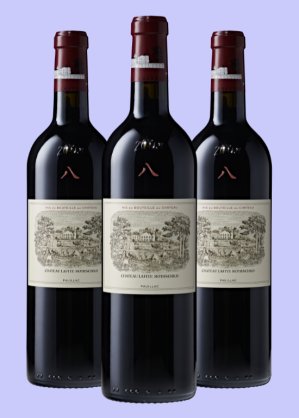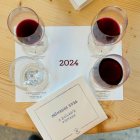
The Evolution of the 1982 Lafite Rothschild
With the 2024 Bordeaux En Primeur campaign in full swing, it is a good moment to take a step back and ask: What does greatness look like, not at release but four decades later? After all, En Primeur is about backing a wine early, watching it grow into something extraordinary and reaping all the rewards the wine has to offer.
To explore this, we turn to the legendary 1982 vintage, widely seen as a turning point in modern Bordeaux. By tracing the evolution of the famed 1982 Lafite through the lens of renowned critics, we can gain an insight into how truly great Bordeaux unravels its rewards over time.
A Vintage Like No Other
What made 1982 so exceptional was its near-perfect rhythm between cool, wet phases and warm, dry stretches during the growing season.
A mild winter gave way to a rainy spring, followed by a warm but not overbearing summer. Then came a dry, sunny autumn, essential for allowing grapes to ripen slowly and evenly without the pressure of harvest-threatening rain. It was this perfect alignment of climate and harvest timing that allowed producers to pick their best fruit.
Crucially, Cabernet Sauvignon, long known for its slow and uneven ripening in Bordeaux, reached full physiological ripeness with a consistency not seen in years. The result was small, concentrated berries with ripe tannins and complex flavour development that not only delivered power and elegance from the start but also promised extraordinary longevity, marking 1982 as a watershed moment in modern Bordeaux.
Early Impressions (Mid to Late 1980s)
While 1982 was the vintage that established Robert Parker Jr as one of modern times’ most influential wine critics, it is interesting to note that Parker only scored the wine between 95 and 96 points.
In his early review published in The Wine Advocate in 1983, Parker described the 1982 Lafite as exhibiting remarkable richness and balance, with notes of ripe blackcurrant fruit, cedar, and a hint of graphite. He emphasised the wine's elegance and potential for long-term ageing, predicting that it would develop further complexity over the decades.
Over the years, Parker steadily revised his assessment, raising the score to 98 in the mid-1990s before eventually awarding the wine a perfect 100 points in 2000.
From an industry perspective, most merchants agreed that Lafite 1982 at release had a quiet strength compared to flashier peers like Mouton or Latour. It was described as a wine for purists, less about power and more about harmony and intellectual pleasure.
Parker’s Perfect Score (2000 Retrospective)
In his retrospective review in a Wine Advocate issue in 2000, Parker awarded the 1982 Lafite a perfect 100 points, describing it as "an amazing achievement!"

"The 1982 Lafite possesses a dark, dense ruby/purple color with only a subtle lightening at the rim. Spectacular aromatics offer jammy cherry and black fruits intertwined with lead pencil, mineral, and smoky wood scents. Powerful for a Lafite, this wine unfolds to reveal extraordinary richness, purity, and overall symmetry in addition to stunning flavour depth and persistence. The finish lasts for nearly a minute."
Robert Parker Jr – The Wine Advocate
He further compared it to Lafite's "immortal 1959," predicting it would enjoy another 30–70 years of life. Around the same time, Michael Broadbent MW also echoed the astounding youthfulness of the 1982 Lafite, describing it as “so much on show, so much left to show”.
In Parker’s last recorded tasting to date at a 1982 Bordeaux 30th Anniversary Gala Luncheon, he recounted a magnum tasting as the greatest example of a 1982 Lafite that he had ever tasted.
It would seem that the 20–30-year mark merely signalled the beginning of the wine’s true drinking window.
Maturity in Motion
In 2022, William Kelley observed that the 1982 Lafite Rothschild had seemingly reached the peak of its powers, with aromas of sweet red berries, blackcurrants, cedar chest, cigar box, camphor, and dried flowers. He described it as medium to full-bodied, supple, and seamless, with an effortlessly elegant, harmonious profile and a long, fragrant finish.
As recently as 2024, Neal Martin noted the wine’s intense black fruit that was infused with cedar and graphite. He described the palate as intense, framed by filigree tannins, and delivering symmetry that leaves one in awe, concluding it still needs more time.
Even at 44 years old, what is most remarkable is how Lafite 1982 feels less like a wine at its peak and more like one just coming into its own. For collectors, it serves as a benchmark for age-worthy Bordeaux, unfolding slowly over time and offering the kind of evolution that makes long-term cellaring not just worthwhile but essential.
Legacy & Lessons
It is easy to assume that the best-lived Bordeaux comes from top producers in top vintages, but true greatness lies in the winemaker’s vigilance throughout the growing season and precision in the cellar. That is what sets exceptional wines apart, regardless of vintage.
The 2024 vintage has been said to be one of the more challenging vintages in recent years, with producers needing to monitor and make vineyard adjustments tirelessly. Historically, such conditions have preceded some of Bordeaux’s most compelling investment-grade wines, underscoring the importance of producer selection over vintage reputation alone.
Just as Lafite 1982 proved the power of precision and patience, 2024 may one day be remembered as a vintage where expertise triumphed over ease.
Should price cuts materialise, this campaign could offer not just cellar-worthy wines but strategic value with long-term upside.
Related Articles

Bordeaux En Primeur 2024 Vintage: A Detailed Analysis
By Tom Gearing





